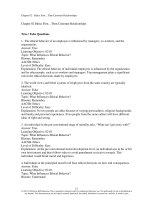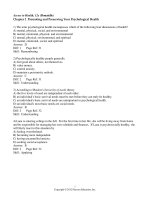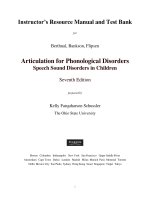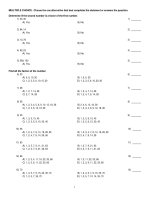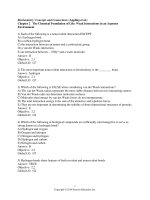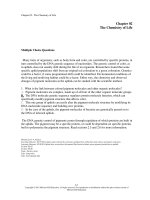Connect core concepts in health 12th edition insel test bank
Bạn đang xem bản rút gọn của tài liệu. Xem và tải ngay bản đầy đủ của tài liệu tại đây (546.9 KB, 34 trang )
CHAPTER 2
STRESS: THE CONSTANT CHALLENGE
Multiple Choice
1.
Which of the following statements is TRUE regarding stress and the lives of college
students?
A.
It is a period of low stress.
B.
It is a period when stress is easily managed.
C.
It may be one of the most stressful periods in one’s life.
D.
It is a period where stress will have little impact on your sense of wellness.
Answer:
C
Page(s):
32
Learning Objective: Explain what stress is and how people react to it – physically,
emotionally, and behaviorally
Topic Area: What is Stress?
Bloom’s Taxonomy: Knowledge
2.
The term stress refers to
A.
an unpleasant situation that disrupts normal activity.
B.
situations that can trigger physical and emotional reactions.
C.
a physical reaction to fright.
D.
any imbalance of homeostasis.
Answer:
B
Page(s):
32
Learning Objective: Explain what stress is and how people react to it – physically,
emotionally, and behaviorally
Topic Area: What is Stress?
Bloom’s Taxonomy: Knowledge
3.
Situations that trigger physical and emotional reactions are termed
A.
stress responses.
B.
stressors.
C.
unmanaged stress.
D.
distress.
Answer:
B
Page(s):
32
Learning Objective: Explain what stress is and how people react to it – physically,
emotionally, and behaviorally
Topic Area: What is Stress?
Bloom’s Taxonomy: Knowledge
4.
Which one of the following is a stressor?
A.
bad grade
B.
sweaty palms
C.
rapid pulse
1
D.
high fever
Answer:
A
Page(s):
32
Learning Objective: Explain what stress is and how people react to it – physically,
emotionally, and behaviorally
Topic Area: What is Stress?
Bloom’s Taxonomy: Knowledge
5.
Which of the following systems are responsible for your body’s physical response to
stressors?
A.
cardiovascular and respiratory
B.
nervous and endocrine
C.
digestive and lymph
D.
muscular and skeletal
Answer:
B
Page(s):
32-33
Learning Objective: Explain what stress is and how people react to it – physically,
emotionally, and behaviorally
Topic Area: What is Stress?
Bloom’s Taxonomy: Knowledge
6.
The autonomic nervous system controls all the following, EXCEPT the
A.
ability to digest food.
B.
speed of your heart rate.
C.
ability to write.
D.
ability to alter your blood pressure.
Answer:
C
Page(s):
32
Learning Objective: Explain what stress is and how people react to it – physically,
emotionally, and behaviorally
Topic Area: What is Stress?
Bloom’s Taxonomy: Knowledge
7.
The parasympathetic branch of the autonomic nervous system
A.
is responsible for mobilizing energy sources for use in a crisis.
B.
activates the endocrine system.
C.
is in control when one is frightened or angry.
D.
aids in digestion and promoting growth.
Answer:
D
Page(s):
32
Learning Objective: Explain what stress is and how people react to it – physically,
emotionally, and behaviorally
Topic Area: What is Stress?
Bloom’s Taxonomy: Knowledge
8.
The branch of the autonomic nervous system that is activated when a person is exposed to a
stressor is the _______________ nervous system.
2
A.
central
B.
somatic
C.
parasympathetic
D.
sympathetic
Answer:
D
Page(s):
32
Learning Objective: Explain what stress is and how people react to it – physically,
emotionally, and behaviorally
Topic Area: What is Stress?
Bloom’s Taxonomy: Knowledge
9.
The system of glands, tissues, and cells that helps control body functions by releasing
hormones is the
A.
central nervous system.
B.
endocrine system.
C.
reproductive system.
D.
digestive system.
Answer:
B
Page(s):
33
Learning Objective: Explain what stress is and how people react to it – physically,
emotionally, and behaviorally
Topic Area: What is Stress?
Bloom’s Taxonomy: Knowledge
10.
During the stress response, the human adrenal glands release
A.
adrenocorticotropic hormone.
B.
epinephrine.
C.
endorphins.
D.
norepinephrine.
Answer:
B
Page(s):
33
Learning Objective: Explain what stress is and how people react to it – physically,
emotionally, and behaviorally
Topic Area: What is Stress?
Bloom’s Taxonomy: Knowledge
11.
During the stress response, which of the following changes occurs throughout the body as a
result of epinephrine being released?
A.
Your hearing and vision become more acute.
B.
Your air passages dilate and allow more air into the lungs.
C.
Your liver releases more sugar into the blood.
D.
Your hearing and vision become more acute, and your air passages dilate and allow
more air into the lungs.
E.
All of the choices are correct.
Answer:
E
Page(s):
33-34
Learning Objective: Explain what stress is and how people react to it – physically,
emotionally, and behaviorally
3
Topic Area: What is Stress?
Bloom’s Taxonomy: Comprehension
12.
Which of the following body reactions is characteristic of the stress response?
A.
Your pupils constrict.
B.
Your blood pressure increases.
C.
Your digestion speeds up.
D.
Your heart rate decreases.
Answer:
B
Page(s):
34
Learning Objective: Explain what stress is and how people react to it – physically,
emotionally, and behaviorally
Topic Area: What is Stress?
Bloom’s Taxonomy: Comprehension
13.
All of the following are TRUE regarding the fight-or-flight reaction, EXCEPT
A.
it is a relatively new human adaptation.
B.
it enables our bodies to prepare quickly escape from an injury.
C.
it prepares our bodies to engage in a physical battle.
D.
it enables our bodies to prepare quickly escape from an injury and prepares our
bodies to engage in a physical battle.
Answer:
A
Page(s):
33-34
Learning Objective: Explain what stress is and how people react to it – physically,
emotionally, and behaviorally
Topic Area: What is Stress?
Bloom’s Taxonomy: Comprehension
14.
The branch of the autonomic nervous system that slows down the body as it recovers from
exposure to a stressor is the _______________ nervous system.
A.
central
B.
somatic
C.
parasympathetic
D.
sympathetic
Answer:
C
Page(s):
33
Learning Objective: Explain what stress is and how people react to it – physically,
emotionally, and behaviorally
Topic Area: What is Stress?
Bloom’s Taxonomy: Knowledge
15.
Homeostasis
A.
is a state of unmanaged stress.
B.
describes the body during the fight-or-flight reaction.
C.
is a state of normal “housekeeping” functions.
D.
is the response of the body to prolonged exposure to stressors.
Answer:
C
4
Page(s):
33
Learning Objective: Explain what stress is and how people react to it – physically,
emotionally, and behaviorally
Topic Area: What is Stress?
Bloom’s Taxonomy: Knowledge
16.
Once the stressful situation ends, your parasympathetic nervous system
A.
increases heart rate.
B.
slows breathing.
C.
slows digestion
D.
increases perspiration.
Answer:
B
Page(s):
33
Learning Objective: Explain what stress is and how people react to it – physically,
emotionally, and behaviorally
Topic Area: What is Stress?
Bloom’s Taxonomy: Comprehension
17.
The somatic nervous system manages
A.
conscious actions.
B.
emotions.
C.
the fight-or-flight reaction to a stressor.
D.
hormones released in response to a stressor.
Answer:
A
Page(s):
35
Learning Objective: Explain what stress is and how people react to it – physically,
emotionally, and behaviorally
Topic Area: What is Stress?
Bloom’s Taxonomy: Knowledge
18.
Which of the following nervous systems manages John’s moves as he participates in a
spinning exercise class?
A.
autonomic
B.
sympathetic
C.
parasympathetic
D.
somatic
Answer:
D
Page(s):
35
Learning Objective: Explain what stress is and how people react to it – physically,
emotionally, and behaviorally
Topic Area: What is Stress?
Bloom’s Taxonomy: Application
19.
The sum of cognitive, behavioral, and emotional tendencies refers to one’s
A.
personality.
B.
wellness.
C.
happiness.
5
D.
ability to succeed in life.
Answer:
A
Page(s):
35
Learning Objective: Explain what stress is and how people react to it – physically,
emotionally, and behaviorally
Topic Area: What is Stress?
Bloom’s Taxonomy: Knowledge
20.
The personality type associated with relaxation and contemplation is
A.
Type A
B.
Type B
C.
Type C
D.
Type D
Answer:
B
Page(s):
35
Learning Objective: Explain what stress is and how people react to it – physically,
emotionally, and behaviorally
Topic Area: What is Stress?
Bloom’s Taxonomy: Knowledge
21.
An individual with a Type C personality is characterized by
A.
having a greater tolerance of others.
B.
being contemplative.
C.
having difficulty expressing emotions.
D.
being controlling.
Answer:
C
Page(s):
35
Learning Objective: Explain what stress is and how people react to it – physically,
emotionally, and behaviorally
Topic Area: What is Stress?
Bloom’s Taxonomy: Knowledge
22.
A person who suppresses anger and feels hopeless has characteristics of which personality
type?
A.
Type A
B.
Type B
C.
Type C
D.
Type D
Answer:
C
Page(s):
35
Learning Objective: Explain what stress is and how people react to it – physically,
emotionally, and behaviorally
Topic Area: What is Stress?
Bloom’s Taxonomy: Knowledge
23.
Which statement about people with hardy personalities is FALSE?
A.
They view stressors as challenges.
6
B.
They tend to perceive fewer situations as stressful.
C.
They tend to believe their lives are controlled by outside factors.
D.
They feel at least partly in control of their lives.
Answer:
C
Page(s):
35-36
Learning Objective: Explain what stress is and how people react to it – physically,
emotionally, and behaviorally
Topic Area: What is Stress?
Bloom’s Taxonomy: Comprehension
24.
An example of a resilient person would be
A.
a low-income student graduating from college.
B.
a fit person completing a marathon.
C.
an intelligent person failing an exam.
D.
a person with a disability going undiagnosed.
Answer:
A
Page(s):
36
Learning Objective: Explain what stress is and how people react to it – physically,
emotionally, and behaviorally
Topic Area: What is Stress?
Bloom’s Taxonomy: Application
25.
The way in which an individual responds to stress is influenced by
A.
biological predispositions.
B.
past experiences.
C.
current circumstances.
D.
personality type.
E.
All of these influence the way an individual response to stress.
Answer:
E
Page(s):
35-36
Learning Objective: Explain what stress is and how people react to it – physically,
emotionally, and behaviorally
Topic Area: What is Stress?
Bloom’s Taxonomy: Comprehension
26.
The more intense an emotional response to a stressor, the __________ the physical response
will be.
A.
weaker
B.
stronger
C.
a or b
D.
It makes no difference.
Answer:
B
Page(s):
37
Learning Objective: Explain what stress is and how people react to it – physically,
emotionally, and behaviorally
Topic Area: What is Stress?
Bloom’s Taxonomy: Knowledge
7
27.
According to the American Psychological Association, the percentage of adult Americans
who suffer from stress-related health problems is between
A.
40 and 50 percent.
B.
50 and 60 percent.
C.
60 and 70 percent.
D.
70 and 80 percent.
Answer:
A
Page(s):
37
Learning Objective: Describe the relationship between stress and disease
Topic Area: Stress and Health
Bloom’s Taxonomy: Knowledge
28.
GAS is an acronym for
A.
genetically alleviated stress.
B.
growth adjustment of stress.
C.
general adaptation syndrome.
D.
general acceleration due to stress.
Answer:
C
Page(s):
37
Learning Objective: Describe the relationship between stress and disease
Topic Area: Stress and Health
Bloom’s Taxonomy: Knowledge
29.
Eustress
A.
is stress that is triggered by something pleasant.
B.
is much more common than distress.
C.
does not trigger the stress response.
D.
is a specific type of distress.
Answer:
A
Page(s):
37
Learning Objective: List common sources of stress
Topic Area: List common sources of stress
Bloom’s Taxonomy: Knowledge
30.
Mohammed just received an F on his term paper. Which type of stress is he likely to
experience?
A.
eustress
B.
malstress
C.
distress
D.
unmanaged stress
Answer:
C
Page(s):
37
Learning Objective: List common sources of stress
Topic Area: List common sources of stress
Bloom’s Taxonomy: Comprehension
8
31.
The fight-or-flight reaction occurs during which stage of the general adaptation syndrome?
A.
alarm
B.
resistance
C.
exhaustion
D.
recovery
Answer:
A
Page(s):
37
Learning Objective: Explain what stress is and how people react to it – physically,
emotionally, and behaviorally
Topic Area: What is Stress?
Bloom’s Taxonomy: Knowledge
32.
Tom is very anxious about an upcoming exam. He has no appetite, is easily distracted, and
has a headache. In what stage of the general adaptation syndrome is Tom?
A.
alarm
B.
acceleration
C.
resistance
D.
exhaustion
Answer:
A
Page(s):
37
Learning Objective: Describe the relationship between stress and disease
Topic Area: Stress and Health
Bloom’s Taxonomy: Analysis
33.
During the resistance stage of the general adaptation syndrome, the body
A.
is in a relaxed state.
B.
responds to the activation of the sympathetic nervous system.
C.
readjusts, regulating body systems to establish a new level of homeostasis.
D.
can no longer react effectively to normal life situations.
Answer:
C
Page(s):
37
Learning Objective: Describe the relationship between stress and disease
Topic Area: Stress and Health
Bloom’s Taxonomy: Comprehension
34.
General exhaustion results when
A.
the fight-or-flight reaction is resolved.
B.
stress-related hormones are secreted.
C.
distress occurs.
D.
a stressor persists over a long period of time.
Answer:
D
Page(s):
37
Learning Objective: Describe the relationship between stress and disease
Topic Area: Stress and Health
Bloom’s Taxonomy: Knowledge
9
35.
Which one of the following is NOT a stage of the general adaptation syndrome?
A.
alarm
B.
acceleration
C.
resistance
D.
exhaustion
Answer:
B
Page(s):
37
Learning Objective: Describe the relationship between stress and disease
Topic Area: Stress and Health
Bloom’s Taxonomy: Comprehension
36.
The result of the exhaustion stage of the general adaptation syndrome may include all of the
following, EXCEPT
A.
maintenance of homeostasis.
B.
death.
C.
distorted perceptions.
D.
disorganized thinking.
Answer:
A
Page(s):
37
Learning Objective: Describe the relationship between stress and disease
Topic Area: Stress and Health
Bloom’s Taxonomy: Comprehension
37.
The long-term wear and tear of the stress response has been termed
A.
eustress.
B.
distress.
C.
homeostasis.
D.
the allostatic load.
Answer:
D
Page(s):
38
Learning Objective: Describe the relationship between stress and disease
Topic Area: Stress and Health
Bloom’s Taxonomy: Knowledge
38.
Which one of the following has been linked to a high allostatic load?
A.
obesity
B.
hypertension
C.
reduced immune function
D.
obesity and hypertension
E.
All of these choices are correct.
Answer:
E
Page(s):
38
Learning Objective: Describe the relationship between stress and disease
Topic Area: Stress and Health
Bloom’s Taxonomy: Comprehension
39.
Which of the following statements is FALSE regarding a high allostatic load?
10
A.
A high allostatic load is linked with physical wellness.
B.
A high allostatic load is linked with hypertension.
C.
A high allostatic load is linked with obesity.
D.
A high allostatic load is linked with heart disease.
Answer:
A
Page(s):
38
Learning Objective: Describe the relationship between stress and disease
Topic Area: Stress and Health
Bloom’s Taxonomy: Comprehension
40.
Which of the following is a hormone involved in the regulation of mood and social
interaction?
A.
insulin
B.
oxygen
C.
niacin
D.
oxytocin
Answer:
D
Page(s):
38
Learning Objective: Describe the relationship between stress and disease
Topic Area: Stress and Health
Bloom’s Taxonomy: Knowledge
41.
Psychoneuroimmunology (PNI) is the study of the interaction among all the following
systems, EXCEPT the _______________ system.
A.
nervous
B.
endocrine
C.
immune
D.
respiratory
Answer:
D
Page(s):
39
Learning Objective: Describe the relationship between stress and disease
Topic Area: Stress and Health
Bloom’s Taxonomy: Comprehension
42.
Shauna expects all of the following to happen when she is stressed, EXCEPT
A.
an increase in heart rate.
B.
a dilation of her blood vessels.
C.
an increase in blood pressure.
D.
an increased risk of developing cardiovascular disease.
Answer:
B
Page(s):
34, 39
Learning Objective: Explain what stress is and how people react to it – physically,
emotionally, and behaviorally
Topic Area: What is Stress?
Bloom’s Taxonomy: Comprehension
11
43.
Which one of the following characteristics is most closely associated with elevated risk of
cardiovascular disease?
A.
hostility
B.
excitability
C.
lack of purpose
D.
procrastination
Answer:
A
Page(s):
39
Learning Objective: Describe the relationship between stress and disease
Topic Area: Stress and Health
Bloom’s Taxonomy: Comprehension
44.
Stress has been found to contribute to which of the following psychological problems?
A.
depression
B.
post-traumatic stress disorder
C.
eating disorders
D.
depression and eating disorders
E.
All of the choices are correct.
Answer:
E
Page(s):
40
Learning Objective: Describe the relationship between stress and disease
Topic Area: Stress and Health
Bloom’s Taxonomy: Application
45.
Which one of the following has NOT been linked to unmanaged stress?
A.
psychological problems
B.
pregnancy complications
C.
digestive problems
D.
glaucoma
Answer:
D
Page(s):
40
Learning Objective: Describe the relationship between stress and disease
Topic Area: Stress and Health
Bloom’s Taxonomy: Comprehension
46.
Which of the following statements is FALSE regarding stress?
A.
Positive events are less stressful than negative events.
B.
The college years are often one of the most stressful periods of a person’s life.
C.
Changes in one’s life are significant stressors.
D.
Financial problems are significant stressors.
Answer:
A
Page(s):
40, 41-42
Learning Objective: List common sources of stress
Topic Area: Common Sources of Stress
Bloom’s Taxonomy: Comprehension
47.
The primary determinant of the health consequences of stress is
12
A.
whether it is emotional or physical stress.
B.
whether it is pleasant or unpleasant stress.
C.
how long the stress has been present.
D.
how the individual responds to the stress.
Answer:
D
Page(s):
40
Learning Objective: Describe the relationship between stress and disease
Topic Area: Stress and Health
Bloom’s Taxonomy: Knowledge
48.
About 90 percent of all headaches are
A.
tension headaches.
B.
migraines.
C.
cluster headaches.
D.
sinus headaches.
Answer:
A
Page(s):
41
Learning Objective: Describe the relationship between stress and disease
Topic Area: Stress and Health
Bloom’s Taxonomy: Knowledge
49.
The majority of migraine sufferers are
A.
men.
B.
women.
C.
teenagers.
D.
elderly.
Answer:
B
Page(s):
41
Learning Objective: Describe the relationship between stress and disease
Topic Area: Stress and Health
Bloom’s Taxonomy: Knowledge
50.
According to your text, which of the following are common sources of stress for most college
students?
A.
academic demands and time management concerns
B.
children and pets
C.
laundry and dishes
D.
involvement in political causes
Answer:
A
Page(s):
41
Learning Objective: Describe techniques for preventing and managing stress
Topic Area: Managing Stress
Bloom’s Taxonomy: Knowledge
51.
Americans rate ________ as a key source of stress in their lives.
A.
work
B.
money
13
C.
children
D.
sexual problems
Answer:
A
Page(s):
42
Learning Objective: List common sources of stress
Topic Area: Common Sources of Stress
Bloom’s Taxonomy: Knowledge
52.
New technologies can be
A.
time-savers.
B.
new sources of stress.
C.
new sources of lessening stress.
D.
all of the above.
Answer:
D
Page(s):
42
Learning Objective: List common sources of stress
Topic Area: Common Sources of Stress
Bloom’s Taxonomy: Knowledge
53.
Acts of violence, industrial accidents, and intrusive noises are examples of
A.
external stressors.
B.
social stressors.
C.
internal stressors.
D.
environmental stressors.
Answer:
D
Page(s):
42
Learning Objective: List common sources of stress
Topic Area: Common Sources of Stress
Bloom’s Taxonomy: Analysis
54.
Unrealistic expectations are a type of _______________ stressor.
A.
interpersonal
B.
internal
C.
environmental
D.
social
Answer:
B
Page(s):
43
Learning Objective: List common sources of stress
Topic Area: Common Sources of Stress
Bloom’s Taxonomy: Knowledge
55.
Which of the following would be the LEAST effective strategy for coping with stress?
A.
denying the reality of the stress
B.
exercising
C.
improving time-management skills
D.
maintaining a strong social support system
14
Answer:
A
Page(s):
43, 48-49
Learning Objective: Describe techniques for preventing and managing stress
Topic Area: Managing Stress
Bloom’s Taxonomy: Comprehension
56.
If you are still emotionally distressed days or weeks after a tragic event,
A.
that is normal; give yourself more time.
B.
consider sharing your feelings with others.
C.
consider seeking professional help.
D.
A and B
Answer:
C
Page(s):
44
Learning Objective: Describe techniques for preventing and managing stress
Topic Area: Managing Stress
Bloom’s Taxonomy: Application
57.
Which of the following statements is FALSE regarding exercise and its ability to help
manage stress?
A.
Exercise enhances one’s sense of general well-being.
B.
Exercise reduces energy levels.
C.
Exercise reduces anxiety levels.
D.
Exercise decreases tension.
Answer:
B
Page(s):
46
Learning Objective: Describe techniques for preventing and managing stress
Topic Area: Managing Stress
Bloom’s Taxonomy: Comprehension
58.
Which of the following statements is TRUE regarding exercise and its ability to help manage
stress?
A.
A long walk can help increase blood pressure.
B.
A brisk 10-minute walk can relax and energize you up to ten hours.
C.
Three 45-minute walks per week can increase your sense of wellness.
D.
A and C
Answer:
C
Page(s):
46
Learning Objective: Describe techniques for preventing and managing stress
Topic Area: Managing Stress
Bloom’s Taxonomy: Comprehension
59.
Exercise can
A.
increase your blood pressure.
B.
become another stressor in a highly stressed life.
C.
improve your sense of wellness.
D.
B and C
Answer:
D
15
Page(s):
46
Learning Objective: Describe techniques for preventing and managing stress
Topic Area: Managing Stress
Bloom’s Taxonomy: Knowledge
60.
Which of the following is NOT a reason why one should avoid or limit caffeine as a stress
management technique?
A.
Caffeine is mildly addictive.
B.
Caffeine is associated with irritability.
C.
Caffeine might cause sleeplessness.
D.
Caffeine acts as a sedative.
Answer:
D
Page(s):
46
Learning Objective: Describe techniques for preventing and managing stress
Topic Area: Managing Stress
Bloom’s Taxonomy: Comprehension
61.
All of the following occur in non-REM sleep, EXCEPT
A.
the release of growth hormone.
B.
a drop in heart rate.
C.
slower and more even brain waves.
D.
the occurrence of dreams.
Answer:
D
Page(s):
47
Learning Objective: Describe techniques for preventing and managing stress
Topic Area: Managing Stress
Bloom’s Taxonomy: Comprehension
62.
Peak concentrations of the levels of stress hormones in the bloodstream occur
A.
just before dinner.
B.
just after lunch.
C.
just before bedtime.
D.
during the final stages of sleep.
Answer:
D
Page(s):
47
Learning Objective: Describe techniques for preventing and managing stress
Topic Area: Managing Stress
Bloom’s Taxonomy: Knowledge
63.
Regarding a good night’s sleep,
A.
American adults sleep an average of less than 6 hours per night.
B.
the body is completely still and relaxed during REM.
C.
the more sleep you get, the lower your stress levels.
D.
an increase in total sleep time causes an increase in the level of stress hormones.
Answer:
A
Page(s):
47
Learning Objective: Describe techniques for preventing and managing stress
16
Topic Area: Managing Stress
Bloom’s Taxonomy: Knowledge
64.
If you are bothered by insomnia, you may try
A.
going to bed at the same time and getting up at the same time seven days per week.
B.
taking several naps during the day.
C.
exercising just before bedtime to ensure fatigue.
D.
all of the above.
Answer:
A
Page(s):
48
Learning Objective: Describe techniques for preventing and managing stress
Topic Area: Managing Stress
Bloom’s Taxonomy: Application
65.
The biggest single time-management problem for most people is
A.
procrastination.
B.
list writing.
C.
goal setting.
D.
overconfidence.
Answer:
A
Page(s):
48-49
Learning Objective: Describe techniques for preventing and managing stress
Topic Area: Managing Stress
Bloom’s Taxonomy: Knowledge
66.
According to your text, a person seeking to overcome procrastination should
A.
avoid asking others for help.
B.
do favorite tasks first to build up momentum.
C.
make narrow time frames to complete tasks.
D.
divide tasks into groups that can be prioritized.
Answer:
D
Page(s):
48
Learning Objective: Describe techniques for preventing and managing stress
Topic Area: Managing Stress
Bloom’s Taxonomy: Knowledge
67.
Which one of the following statements reflects your text’s recommendations regarding the
prioritization of tasks?
A.
Tasks should be divided into two groups: hard and easy.
B.
Tasks should be divided into three groups, and you should ignore the least important
group.
C.
Some attention should be paid to all tasks, even if it is only a few minutes.
D.
Priorities should be based on whether or not you like performing the task.
Answer:
B
17
Page(s):
48
Learning Objective: Describe techniques for preventing and managing stress
Topic Area: Managing Stress
Bloom’s Taxonomy: Application
68.
In terms of time-management strategies, which one of the following is NOT considered
helpful to you in improving your efficiency at completing your tasks?
A.
aiming for realistic goals
B.
writing down your goals
C.
memorizing your goals
D.
allowing more time to achieve your goals than you actually expect them to take
Answer:
C
Page(s):
48
Learning Objective: Describe techniques for preventing and managing stress
Topic Area: Managing Stress
Bloom’s Taxonomy: Comprehension
69.
All of the following are recommended by your text as time-management strategies, EXCEPT
A.
setting priorities.
B.
breaking down long-term goals into short term ones.
C.
avoiding unstructured time.
D.
keeping track of tasks you put off.
Answer:
C
Page(s):
48-49
Learning Objective: Describe techniques for preventing and managing stress
Topic Area: Managing Stress
Bloom’s Taxonomy: Comprehension
70.
Which of the following would NOT be helpful to you in attempting to improve your
productivity?
A.
Focus on long-term goals only.
B.
Visualize achievement of your goals.
C.
Delegate responsibility.
D.
Say “no” when necessary.
Answer:
A
Page(s):
48-49
Learning Objective: Describe techniques for preventing and managing stress
Topic Area: Managing Stress
Bloom’s Taxonomy: Comprehension
71.
Because watching television is usually a “time sink” while you are on a deadline, it is wise to
A.
limit your television break to 5-10 minutes.
B.
avoid turning on the television.
C.
realize you need a break and just watch a few shows.
D.
surf the Internet for a few minutes instead.
Answer:
B
Page(s):
49
18
Learning Objective: Describe techniques for preventing and managing stress
Topic Area: Managing Stress
Bloom’s Taxonomy: Application
72.
Which one of the following is a cognitive technique for stress management?
A.
progressive relaxation
B.
imagery
C.
meditation
D.
thinking constructively
Answer:
D
Page(s):
50
Learning Objective: Describe techniques for preventing and managing stress
Topic Area: Managing Stress
Bloom’s Taxonomy: Knowledge
73.
Which one of the following is NOT a cognitive technique for stress management?
A.
solving problems
B.
setting moderate expectations
C.
maintaining positivity
D.
using imagery
Answer:
D
Page(s):
50-52
Learning Objective: Describe techniques for preventing and managing stress
Topic Area: Managing Stress
Bloom’s Taxonomy: Comprehension
74.
Laughter does all of the following, EXCEPT
A.
aid digestion.
B.
increase pulse rate.
C.
ease pain.
D.
lower blood pressure.
Answer:
D
Page(s):
51
Learning Objective: Describe techniques for preventing and managing stress
Topic Area: Managing Stress
Bloom’s Taxonomy: Comprehension
75.
Laughter may be the best medicine for stress because after a good laugh your
A.
heart rate is increased.
B.
muscles are relaxed.
C.
blood pressure is increased.
D.
stress levels return to their pre-laughter level.
Answer:
B
Page(s):
51
Learning Objective: Describe techniques for preventing and managing stress
Topic Area: Managing Stress
Bloom’s Taxonomy: Comprehension
19
76.
A helpful behavior in dealing with stressful situations is to
A.
keep a mental log of past mistakes and errors as an instant reference.
B.
cultivate the ability to laugh at yourself.
C.
attempt to fulfill others’ expectations.
D.
work hard so that you can play hard.
Answer:
B
Page(s):
51
Learning Objective: Describe techniques for preventing and managing stress
Topic Area: Managing Stress
Bloom’s Taxonomy: Knowledge
77.
Philip is attempting to deal with his stress. Which of the following would NOT be helpful?
A.
thinking and acting constructively
B.
keeping his expectations at moderate and achievable levels
C.
trying to remember as much information as possible
D.
living in the present
Answer:
C
Page(s):
50-51
Learning Objective: Describe techniques for preventing and managing stress
Topic Area: Managing Stress
Bloom’s Taxonomy: Comprehension
78.
Which one of the following statements is FALSE regarding the relaxation response?
A.
Metabolism and oxygen consumption are reduced.
B.
Brain waves shift from an alert beta rhythm to a relaxed alpha rhythm.
C.
Blood flow to the brain and skin is reduced.
D.
You may feel an overall warmth and quiet mental alertness.
Answer:
C
Page(s):
51
Learning Objective: Describe techniques for preventing and managing stress
Topic Area: Managing Stress
Bloom’s Taxonomy: Comprehension
79.
Progressive relaxation techniques
A.
involve tensing and then relaxing the muscles in your body.
B.
increase heart rate.
C.
involve a lot of imagination and willpower.
D.
can be quite complex and difficult to master.
Answer:
A
Page(s):
51-52
Learning Objective: Describe techniques for preventing and managing stress
Topic Area: Managing Stress
Bloom’s Taxonomy: Knowledge
80.
Which one of the following statements is TRUE of progressive relaxation?
20
A.
B.
C.
D.
It is based on the use of your imagination and your skill at imagery.
It requires no willpower or imagination.
It increases oxygen consumption to the muscles.
It is the only relaxation technique that also permits you to achieve cardiovascular
fitness benefits.
Answer:
B
Page(s):
51-52
Learning Objective: Describe techniques for preventing and managing stress
Topic Area: Managing Stress
Bloom’s Taxonomy: Comprehension
81.
Progressive relaxation is best described by which one of the following statements?
A.
It is a mental exercise that requires special training to address stress.
B.
It is a form of cognitive development.
C.
It is a process that uses simple tensing and relaxing of muscles.
D.
It is an aerobic exercise.
Answer:
C
Page(s):
51-52
Learning Objective: Describe techniques for preventing and managing stress
Topic Area: Managing Stress
Bloom’s Taxonomy: Knowledge
82.
Which one of the following statements is FALSE regarding imagery?
A.
Visualizing yourself performing a task can help improve performance.
B.
Imagery can be an aid in changing habits.
C.
Imagery can enhance physical performance.
D.
Imagery is a cognitive technique designed to change typical patterns of thinking.
Answer:
D
Page(s):
52
Learning Objective: Describe techniques for preventing and managing stress
Topic Area: Managing Stress
Bloom’s Taxonomy: Comprehension
83.
Carey would like to use meditation to help her manage her stress. Which of the following is
likely to happen as a result of her use of this technique?
A.
It will help her tune out the world, temporarily removing sources of stress.
B.
It will help her rehearse upcoming events so that stress in her life will be reduced.
C.
It will help her to analyze the stressors in her life more effectively.
D.
It will help her visualize her tasks that need to be completely in a more efficient way.
Answer:
A
Page(s):
52
Learning Objective: Describe techniques for preventing and managing stress
Topic Area: Managing Stress
Bloom’s Taxonomy: Comprehension
84.
A stress management technique that focuses primarily on your breathing pattern is called
A.
hatha yoga.
21
B.
deep breathing.
C.
t’ai chi ch’uan.
D.
laughter.
Answer:
B
Page(s):
53
Learning Objective: Describe techniques for preventing and managing stress
Topic Area: Managing Stress
Bloom’s Taxonomy: Knowledge
85.
Which of the following stress management techniques emphasizes the use of breathing,
stretching, and balance?
A.
meditation
B.
hatha yoga
C.
visualization
D.
progressive relaxation
Answer:
B
Page(s):
53
Learning Objective: Describe techniques for preventing and managing stress
Topic Area: Managing Stress
Bloom’s Taxonomy: Knowledge
86.
Tai chi can be an effective stress reducer as it
A.
teaches students to remain calm and centered.
B.
is an excellent cardiovascular workout.
C.
aids the student in working against various stressors.
D.
is easily self-taught.
Answer:
A
Page(s):
53
Learning Objective: Describe techniques for preventing and managing stress
Topic Area: Managing Stress
Bloom’s Taxonomy: Knowledge
87.
Biofeedback helps people reduce stress by
A.
removing internal and external stressors.
B.
cleaning the body of toxins.
C.
increasing muscle strength and flexibility.
D.
enabling them to become more aware of their levels of physiological arousals.
Answer:
D
Page(s):
53-54
Learning Objective: Describe techniques for preventing and managing stress
Topic Area: Managing Stress
Bloom’s Taxonomy: Knowledge
88.
All of these are considered counterproductive coping strategies, EXCEPT
A.
tobacco use.
B.
drug abuse.
C.
use of a multivitamin.
22
D.
alcohol use.
Answer:
C
Page(s):
54-55
Learning Objective: Describe techniques for preventing and managing stress
Topic Area: Managing Stress
Bloom’s Taxonomy: Comprehension
89.
Approximately _______ of Americans use food as a coping device against stress.
A.
20 to 30 percent
B.
30 to 40 percent
C.
40 to 50 percent
D.
more than 50 percent
Answer:
A
Page(s):
55
Learning Objective: Describe techniques for preventing and managing stress
Topic Area: Managing Stress
Bloom’s Taxonomy: Knowledge
90.
The first step in creating a personal plan for managing stress is to
A.
design your plan.
B.
identify your stressors.
C.
seek professional help.
D.
investigate support groups.
Answer:
B
Page(s):
56
Learning Objective: Put together a plan for successfully managing the stress in your life
Topic Area: Creating a Personal Plan For Managing Stress
Bloom’s Taxonomy: Analysis
True/False
91.
A stressful situation would be one an individual perceives as challenging.
Answer:
False
Page(s):
32
Learning Objective: Explain what stress is and how people react to it – physically,
emotionally, and behaviorally
Topic Area: What is Stress?
Bloom’s Taxonomy: Knowledge
92.
The stress response in the human being is triggered by a nonspecific agent called a stressor.
Answer:
True
Page(s):
32
Learning Objective: Explain what stress is and how people react to it – physically,
emotionally, and behaviorally
Topic Area: What is Stress?
23
Bloom’s Taxonomy: Knowledge
93.
Responses to stressors include physical and emotional behavioral responses.
Answer:
True
Page(s):
32
Learning Objective: Explain what stress is and how people react to it – physically,
emotionally, and behaviorally
Topic Area: What is Stress?
Bloom’s Taxonomy: Knowledge
94.
The parasympathetic division of the autonomic nervous system initiates the stress response.
Answer:
False
Page(s):
32-33
Learning Objective: Explain what stress is and how people react to it – physically,
emotionally, and behaviorally
Topic Area: What is Stress?
Bloom’s Taxonomy: Knowledge
95.
Endorphins are body-produced chemicals that relieve pain in case of injury.
Answer:
True
Page(s):
33
Learning Objective: Explain what stress is and how people react to it – physically,
emotionally, and behaviorally
Topic Area: What is Stress?
Bloom’s Taxonomy: Knowledge
96.
Homeostasis is the body’s state of normalcy.
Answer:
True
Page(s):
33
Learning Objective: Explain what stress is and how people react to it – physically,
emotionally, and behaviorally
Topic Area: What is Stress?
Bloom’s Taxonomy: Knowledge
97.
The fight-or-flight response prepares the body for physical action regardless of whether
action is needed.
Answer:
True
Page(s):
34
Learning Objective: Explain what stress is and how people react to it – physically,
emotionally, and behaviorally
Topic Area: What is Stress?
Bloom’s Taxonomy: Knowledge
98.
The physical response to a stressor has little variance in intensity from person to person.
Answer:
False
24
Page(s):
34
Learning Objective: Explain what stress is and how people react to it – physically,
emotionally, and behaviorally
Topic Area: What is Stress?
Bloom’s Taxonomy: Knowledge
99.
The physical response to taking a final exam varies in intensity from student to student.
Answer:
True
Page(s):
34
Learning Objective: Explain what stress is and how people react to it – physically,
emotionally, and behaviorally
Topic Area: What is Stress?
Bloom’s Taxonomy: Knowledge
Learning Objective: Explain what stress is and how people react to it – physically,
emotionally, and behaviorally
Topic Area: What is Stress?
Bloom’s Taxonomy: Knowledge
100.
Careful planning and preparation can help make academic stressors more predictable and
manageable.
Answer:
True
Page(s):
34-35
Learning Objective: Describe techniques for preventing and managing stress
Topic Area: Managing Stress
Bloom’s Taxonomy: Knowledge
101.
A stressful situation would be one an individual perceives as exceeding her ability to cope.
Answer:
True
Page(s):
35
Learning Objective: Explain what stress is and how people react to it – physically,
emotionally, and behaviorally
Topic Area: What is Stress?
Bloom’s Taxonomy: Knowledge
102.
The somatic nervous system is largely under conscious control.
Answer:
True
Page(s):
35
Learning Objective: Explain what stress is and how people react to it – physically,
emotionally, and behaviorally
Topic Area: What is Stress?
Bloom’s Taxonomy: Knowledge
103.
Type B personalities tend to be schedule driven, competitive, and even hostile.
Answer:
False
Page(s):
35
25
